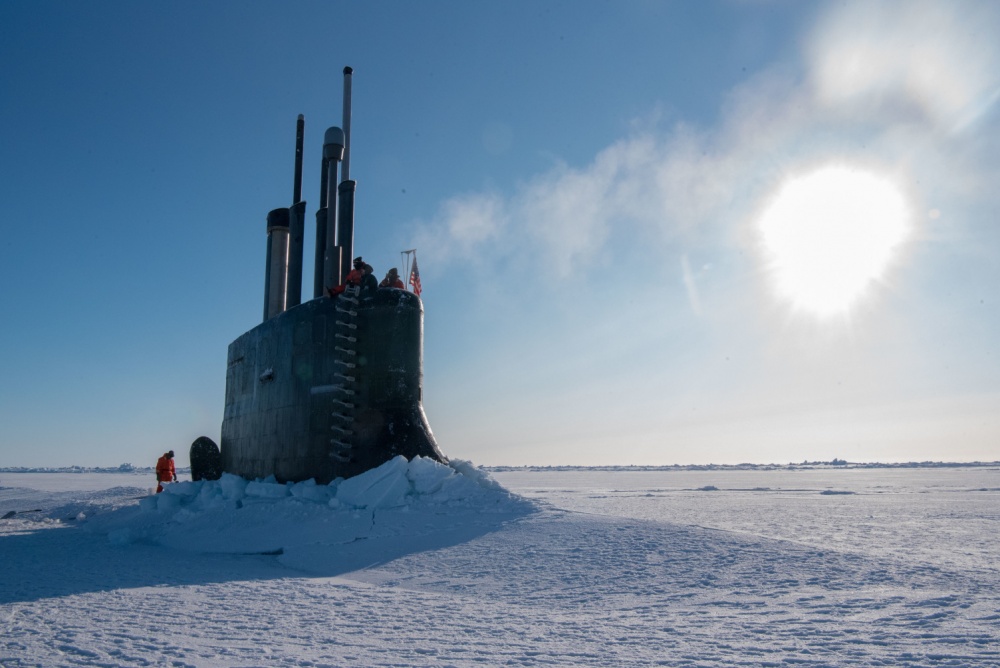The US Navy’s new Arctic strategy is limited in scope and details, say critics
The Navy assesses the Arctic as “low risk of conflict,” with plans to evaluate changes in the environment and the Navy’s capabilities and to establish strong partnerships in the region.

The U.S. Navy quietly released a barebones new Arctic Strategic Outlook earlier this year, which critics say doesn’t do enough to sketch the challenges the agency faces in the Arctic or its capacity to respond. A copy obtained by ArcticToday this week, dated January 2019, offers a brief assessment of risks in the Arctic and an overview of the military branch’s approach to the region.
Last August, Congress called for an updated Arctic strategy from then-Defense Secretary James Mattis to be submitted no later than June 1, 2019. Arctic strategies from both the Navy and the Coast Guard, released last week, will likely form the backbone of the larger Defense Department document.
This strategic outlook supersedes the Navy’s most recent Arctic Roadmap, released in February 2014.
The Navy sees the circumpolar North as having a “low risk of conflict.” According the document, the Navy essentially plans to conduct business as usual in the Arctic — evaluating changes in the environment and the Navy’s capabilities and relying on strong partnerships both within federal agencies and across the Arctic.
At only 14 pages long, including the title page, this strategy lacks the scope and detail — and even attention to design — of the U.S. Coast Guard’s Arctic strategy, observers say.
“I was underwhelmed,” David Titley, a retired U.S. Navy Rear Admiral who now directs the Center for Solutions to Weather and Climate Risk at the Pennsylvania State University, told ArcticToday. “Massively underwhelmed.”
The document wasn’t much of a strategy, Titley said. A strategy identifies problems and potential solutions in service of certain goals, he explained. This short document was light on all of those elements. He summed it up as: “Nothing to see here, folks, move along… lots of other things for us to do right now.”
“It read to me that the U.S. Navy is really not interested at this point in time of committing surface forces or even putting money into developing ice-capable surface forces that in the future could have a robust presence in the Arctic,” Titley said.
Even the document’s plain design sends signals about the Navy’s attention to the Arctic.
“It sort of looks like some commander was told to type this up on a Sunday night,” Titley joked. “It would be hard to think of a much lower-budget production.”
Appearances do send signals, he pointed out. The brief, simplistic document “tells us that maybe this is not a particularly high priority in the Navy,” Titley said. “And then if you read the words, you get nothing to dissuade you from that opinion.”
The Navy assesses the Arctic to be at low risk for conflict because nations in the region have been able to resolve their differences peacefully. At the same time, with a national defense strategy that acknowledges great power competitions and the reemergence of long-term strategic rivalries, the document reads, “the U.S. Navy must remain ready to safeguard our Arctic interests.”
The strategy also discusses the changing environment of the Arctic and accompanying changes in geopolitics, economics, research and more. The Navy sees its main functions in the Arctic as providing deterrence, sea control, power projection, maritime security, logistics support such as sealift operations, search and rescue assistance, and other missions.
The strategy emphasizes the importance of partnerships in the region, including the Arctic Council, Arctic Coast Guard Forum, Combatant Command and other organizations.
In particular, the document highlighted the Navy’s close collaboration in the region with the U.S. Coast Guard, which “fulfills most U.S. maritime missions in the Arctic” with a “mobile and seasonal approach.” (The Coast Guard strategy, on the other hand, mentions the U.S. Navy just once in 46 pages.)
The Navy document also praised close connections with international allies, particularly Canada. According to the document, the United States and Canada share a “unique and enduring defense partnership” vital to both countries’ security interests.
The strategy remarked that the importance of Bering Strait as a “strategic chokepoint” will increase as the region becomes more accessible and crowded. It also mentioned the changing conditions in both the Northern Sea Route and the Northwest Passage, noting that the Navy “will consider implications of increasing maritime traffic in future security planning.”
The document highlights ICEX, the submarine exercises the Navy holds every other year on and under Arctic ice as one of its key efforts to prepare for Arctic environments. Another is freedom of navigation operations, or FONOPS. The strategy specifically called out the Navy’s ability to conduct these public exercises in the Arctic, either beneath or above the surface. “As nations seek economic opportunities in the region, the Navy will contribute to stability and security,” the FONOPS section of the report reads.
Yet for the Navy, other, less peaceful places take priority over the Arctic, the report said.